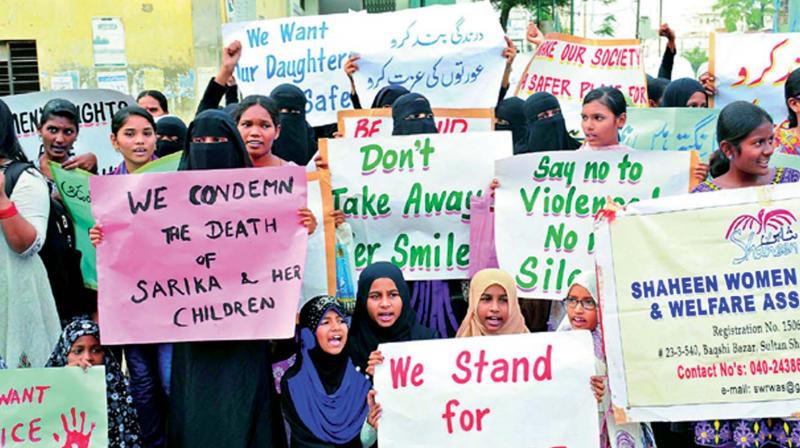Largest democracy low in women representation
Of a total of 193 countries, India ranks 148th with a pathetic show of 11.8 per cent.

A detailed investigation of 193 countries in early 2017 by the Inter Parliamentary Union presented some interesting facts about the representation of women in the Lower (or only) house of Parliament. India, the world’s largest ‘democracy’, is ranked 148th with a pathetic show of 11.8 percent. Many of our Asian neighbours are in a better position. Nepal has 29.6 percent, the Philippines has 29.5 percent, Laos has 27.5 percent, and Vietnam has 26.7 percent. Timor-Leste is ranked 18th in the world with 38.5 percent women parliamentarians. Four countries where women are totally unrepresented are Qatar, Yemen, Vanuatu and Micronesia. In 30 countries, less than 10 percent of parliamentarians are women. In another 29 countries, women comprise 10 -15 percent of the membership.
Asia and the Middle East are hotspots of women’s oppression. China is ranked 74th with 23.7 percent representation for women in parliament. Pakistan with 20.6 percent and Bangladesh with 20.3 percent are far ahead of India in ranking. So is Nepal with an enviable record of 29.6 percent (rank 48). At the very bottom of the ladder we find Oman with 1.2 percent, Papua New Guinea (2.7 pc), Thailand (4.9 pc), Sri Lanka (5.8 pc), the Maldives and Iran (5.9 pc each). Some statistics need to be taken with a pinch of salt. For instance, Afghanistan has 27.7 percent women parliamentarians, the UAE has 20 percent and Saudi Arabia has 19.9 perecnt. Obviously, numbers and percentages don’t tell the whole story.
So who are the winners? Rwanda, a teeny-weeny nation in central Africa, tops the global ranking with 61.3 pc of its parliament members being women.
Many of us would probably never have heard of Rwanda if it hadn’t been notorious for genocide in the mid-1990s. Bolivia in South America is second on the list with 53.1 pc women in parliament. Rwanda and Bolivia are the only two nations whose parliaments have a female majority. Of the 20 countries leading the global race for gender parity (21 to be precise, because both Belgium and the Netherlands are ranked 20th with 38 pc women), 7 are in Africa and 7 in Europe. The European leaders are Iceland, Sweden, Finland, Norway and Spain, whereas the African states are Senegal (ranked 7th), South Africa, Namibia, Mozambique, Ethiopia and Angola. Central and South America have much to be proud of. Cuba is ranked 3rd with 48.9 pc women parliamentarians, Nicaragua 5th with 45.7 pc, Mexico 8th with 42.6 pc, Ecuador 11th with 41.6 pc and Argentina 16th with 38.9 pc.
Germany is ranked 23rd and has 37 pc women in parliament. The United Kingdom has 30 pc women and is ranked 47th. Both these countries have strong women Prime Ministers. The United States of America, the world’s most powerful nation, and the torch-bearer of democratic traditions, is ranked 104 with 19.1 pc. The country’s ranking was 52nd in 1997. It has been estimated that at the current rate of progress (or decline) it would take another 100 years for American women to attain parity in parliament. (They had a chance to elect a woman President in 2016 but chose a male real estate developer over a woman senator.) America’s arch rival Russia has a mere 15.8 pc, so it wouldn’t be wrong to conclude that the two nations are vying with each other to keep their women down.
The Women in Politics Map was launched by the IPU and UN Women a few days ago. It shows that the global average of women in national parliaments increased marginally from 22.6 pc in 2015 to 23.3 pc in 2016. Wow! 0.7% more! How does that feel, ladies? Do you see any major change happening in your lifetime – or that of your daughter or granddaughter? The number of women Heads of State or Heads of Government fell from 19 to 17 since 2015, with Brazil and Argentina no longer headed by women. (Theresa May of Britain has since come into the picture but will Angela Merkel of Germany stay?)
“What is democracy? Is it people for the people, or men for the people?” Phumzile Mlambo-Ngcuka, Executive Director of UN Women, asked while addressing journalists in New York. I would say it is, “Of the men, by the men, for the men”. (Sorry, Lincoln sir!) A 2012 study published in Science found that when more women served in government, parents tended to have higher aspirations for their daughters, and girls had higher aspirations for their own careers. But who’s listening? Is democracy good for women? Well, going by these statistics, it seems the answer is a resounding NO.

